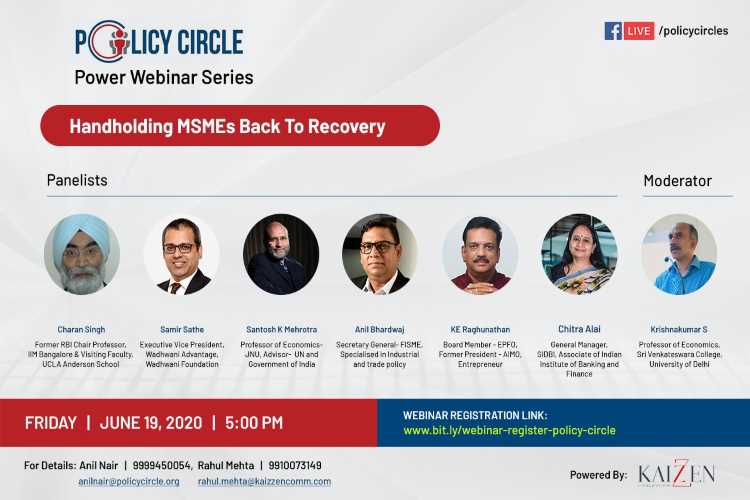India is going through the worst economic crisis since independence. A recent World Bank report sees Indian economy shrinking 3.2% in the current financial year. The government and the Reserve Bank of India have reacted to the situation, but these responses may not be adequate considering the gravity of the situation.
Micro, small and medium enterprises (MSMEs) are the worst sufferers of the current crisis. The 63 million MSMEs account for more than a third of the manufacturing output of the country. They employ at least 120 million people in the non-agricultural sector. MSME sector contributed significantly in the growth of Asian economies since 1980s in terms of total production, exports and employment. The growth of MSME sector in India is not as impressive. The growth in employment in this sector was just 3.63% between 2005-06 and 2015-16 and it has declined further thereafter.
READ I A seven-point plan for MSMEs to survive Covid-19
MSMEs were already in a spot of bother when the Covid-19 pandemic struck. The nationwide lockdown announced by the Narendra Modi government to tackle the new coronavirus outbreak has broken the supply chains of the sector. Its dependence on global production networks and the unprecedented contraction in demand further weakened the sector. Most MSMEs do not receive any institutional credit. The already struggling sector received a jolt when the Covid-19 pandemic broke out, resulting in a sharp fall in revenues. A recent survey showed that a third of MSME units are on the verge of closure.
The crisis could see India falling behind its social inclusion agenda. Around two thirds of MSME units are owned by socially backward castes in India that comprise three fourths of the population in rural India. More than a fifth of MSME units are owned by women. Around 99% of the units are micro units, while 0.8% are small and 0.1% are medium units. The employment potential of this sector is key to achieving the Narendra Modi government’s target of making India a $5 trillion economy.
READ I MSME sector: Eight ways India can back its small enterprises
The government needs to focus on the following six areas for removing the hurdles faced by the MSME sector.
Access to credit: There is a need to ensure adequate finances to keep MSMEs running in these difficult times. While the Reserve Bank of India has taken some steps to address the issue, these steps mostly cater to the large units that already have availed institutional credit.
Innovation, R&D support: Many MSME firms are very small to allot any amount for innovation in production, distribution and marketing processes. As a result, many are stuck at where they started. To capture the global market with indigenous handicraft, handloom and agricultural products, Indian MSME units needs to innovate the product design, procurement and marketing strategies. Considering the size of the units, it needs to be done at the industry level by strengthening the linkages between the industry, R&D institutions and MSME units.
READ I $5 trillion economy: Need bold, innovative initiatives in MSME finding
Marketing, storage and pricing: The sector is dominated by micro units. There is hardly any scope for marketing and storage facilities, affecting the pricing of products. The involvement of middle men in procurement of inputs as well as the marketing of finished products often reduces the negotiating power of these units. Moreover, information asymmetry related to the market and changes in market requirements further pose challenges. When India starts afresh after the restrictions are lifted, the small units will need new systems to help them with fresh energy, ideas and processes.
Digital technology: The Covid-19 pandemic showed that digitisation is essential, if India were to grow in the new world. Effective usage of digital technology can reduce the costs and increase the price of output. Technology can also link units with markets across the country as well as across the world.
READ I Brewing trouble: Indian economy to shrink 3.2% as world slips into deep recession
Skill development: One major reason for the slow growth of the MSME sector is the shortage of skilled labour force. Highly skilled handicraft, handloom and other skill-oriented activities such as stone cutting, embellishment etc. are abandoned by the new generation due to poor wages. Such activities can be converted into an industrial training module to attract the new generation. Another problem is the low mechanisation of these units. They still function with limited and outdated technology. The industry-education linkage can facilitate mechanisation of units. The Covid-19 outbreak proved that Indian technology institutes are capable of responding to the needs of the society proactively. But the question is, whether this can really benefit MSMEs?
Rural development: The MSME sector has huge potential in developing rural India without impacting the environment and utilising the improvements that the nation has achieved in physical and digital connectivity. This will help reduce the pressure on urban spaces for various resources and facilitate widespread development of the country.
As part of its Power Webinar Series, Policy Circle is organising a discussion on the challenges faced by the MSME sector. Titled Handholding MSMEs back to recovery, the discussion will have some of the top experts from the MSME sector, academia, banking and non-profits.

